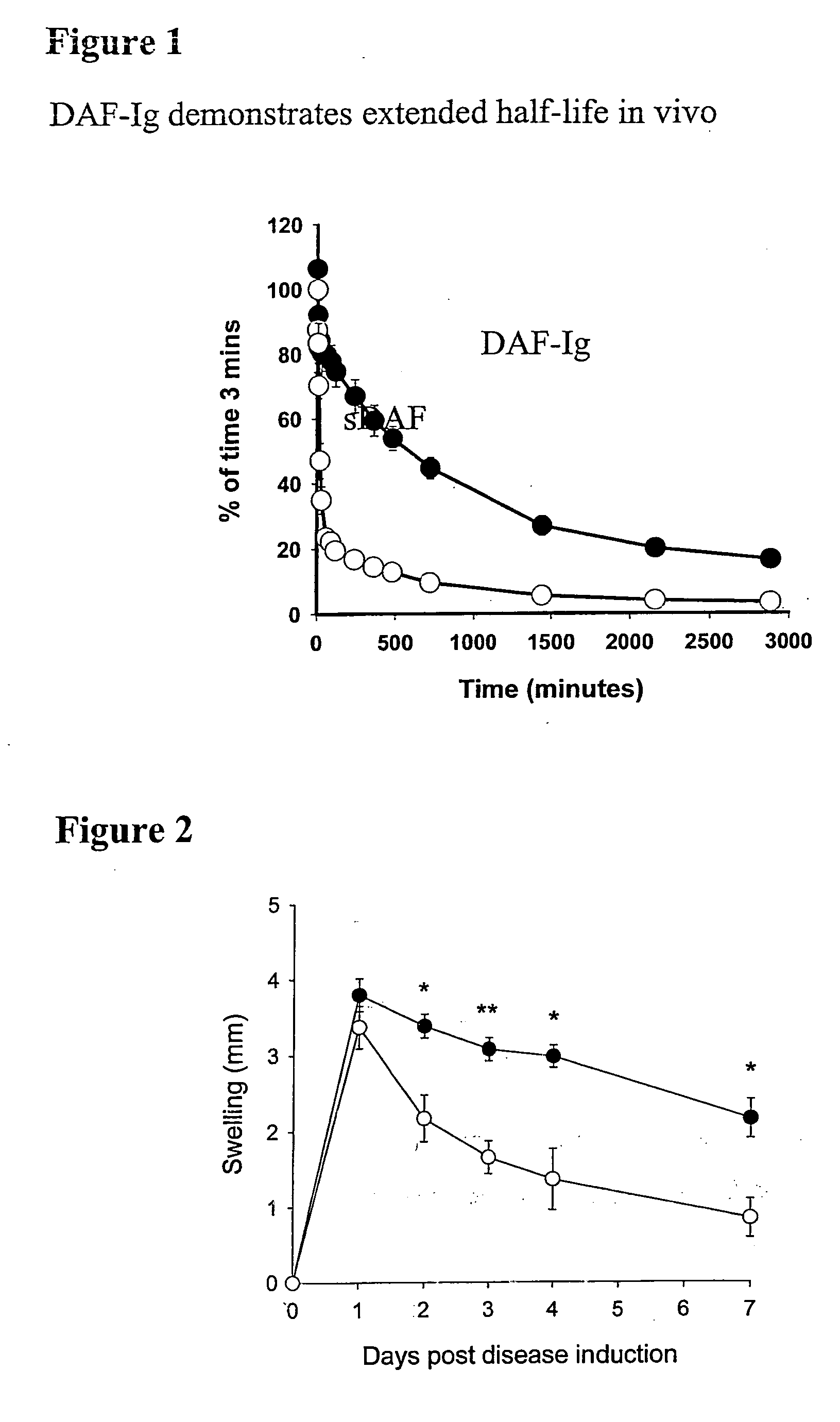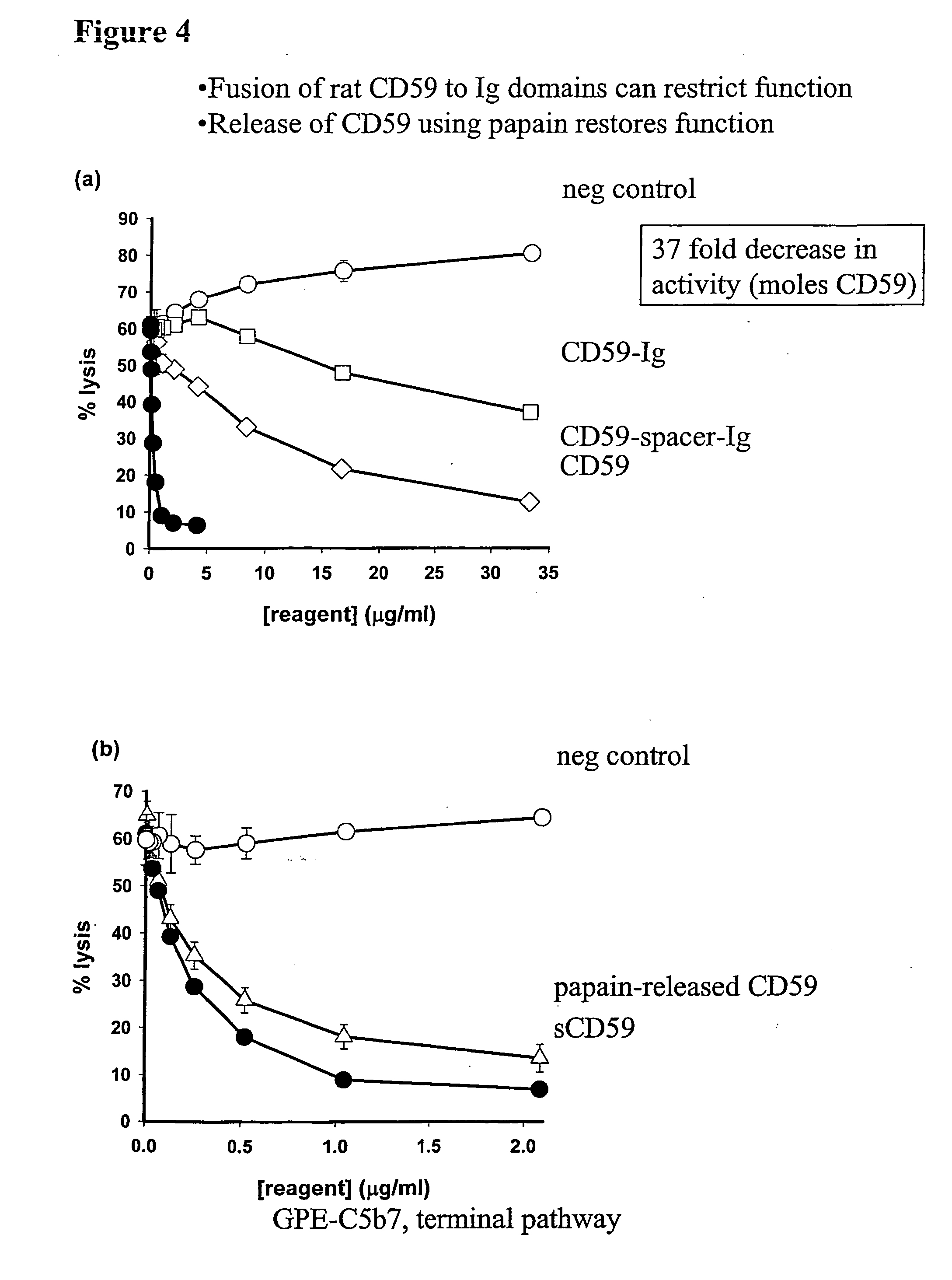Cleavable reagents for specific delivery to disease sites
- Summary
- Abstract
- Description
- Claims
- Application Information
AI Technical Summary
Benefits of technology
Problems solved by technology
Method used
Image
Examples
example 4
Method Example 4
CD59-pacer-Ig According to the Invention
[0100] A CD59-containing fusion protein was also prepared in which the amino acids (Ser-Gly-Gly-Gly-Gly)2-Ser were inserted between CD59 and the antibody hinge using two stage PCR. Briefly, DNA encoding CD59 and the Ig domains was reamplified in two separate reactions using new primers that incorporated the sequence of the spacer domain at the 3′ end of CD59 and at the 5′ end of the Ig hinge. The two PCR products were mixed together and allowed to anneal at complementary DNA sequences encoding the spacer domain. Following PCR using outside primers, the product was ligated into the expression vector pDR2ΔEF1α. Cells were transfected and the second CD59-Ig protein was purified as described above. Protein concentrations were determined using Pierce Comassie assay (Perbio Science UK Ltd, Tattenhall, UK) using bovine serum albumin as a standard.
[0101] CD59-Ig has a mass of 77 Kda, CD59-spacer-Ig has a mass of 78.5 Kda and DAF-Ig h...
example 5
Method Example 5
Human DAF-IgG2 and Human DAF-IgG4 According to the Invention
[0102] Human DAF-IgG1 was generated as described by Harris C L et al. (2000), Immunology, 100, 462. Fusion proteins consisting of human DAF and either IgG2 or IgG4 hinge were generated as follows:
[0103] DNA encoding the hinge and Fc of human IgG4 or IgG2 were amplified by RT-PCR from human peripheral blood lymphocyte RNA. The amino terminal sequences of the antibody hinges are as follows: [0104] IgG4 short hinge: KYGPPC . . . [0105] IgG4 long hinge: VDKRVES . . . [0106] IgG2: ERKCCV . . .
[0107] Primers incorporated restriction sites to enable later ligation into a high expression vector pDR2ΔEF1α ((BamH1 at the 5′ end and EcoRV at the 3′ end). DNA encoding the signal peptide and either the first three or four SCR domains of hDAF was amplified by PCR using plasmid containing DAF sequences as a template. The carboxy-terminal sequences of the DAF domains are as follows: [0108] 3SCR form: . . . PECREIY [0109]...
example 1
In vitro Functional Analyses of DAF-Ig, sDAF, CD59-Ig and CD59-Cleavage by Papain
[0116] The ability of DAF-Ig and sDAF to inhibit the classical pathway of C was analysed using a haemolysis assay and was compared to inhibition of lysis achieved with sCR1. Both sDAF and sCR1 were powerful inhibitors of lysis, while DAF-Ig showed a reduced ability to inhibit lysis (FIG. 3). Tests using papain to cleave Ig from DAF indicated that the functional activity of DAF in vitro could be restored by removal from the Ig. This was shown by the ft that DAF released from Ig domains by digestion with papain, had identical activity to sDAF secreted from CHO cells.
[0117] The ability of CD59-Ig and CD59-spacer-Ig to inhibit C was also tested using haemolysis assays specific for the terminal pathway. Again, the fusion protein showed a much lowered ability to inhibit MAC formation when compared to CD59 released from CD59-Ig using papain. This, like the DAF analysis, indicated that cleavage of the Ig from...
PUM
| Property | Measurement | Unit |
|---|---|---|
| Fraction | aaaaa | aaaaa |
| Composition | aaaaa | aaaaa |
| Therapeutic | aaaaa | aaaaa |
Abstract
Description
Claims
Application Information
 Login to View More
Login to View More - R&D
- Intellectual Property
- Life Sciences
- Materials
- Tech Scout
- Unparalleled Data Quality
- Higher Quality Content
- 60% Fewer Hallucinations
Browse by: Latest US Patents, China's latest patents, Technical Efficacy Thesaurus, Application Domain, Technology Topic, Popular Technical Reports.
© 2025 PatSnap. All rights reserved.Legal|Privacy policy|Modern Slavery Act Transparency Statement|Sitemap|About US| Contact US: help@patsnap.com



